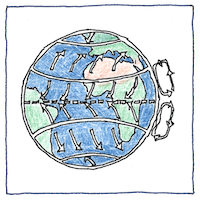George Hadley
atmospheric_sciences

|
Trade winds
George Hadley, the meteorologist of the Royal Society in London, became dissatisfied with Edmond Halley’s explanation for trade winds, particularly that differences in sunshine from morning to evening cause the easterly trade winds. Hadley’s paper, “Concerning the cause of the general trade winds,” describes how heat at the equator and a lack of heat at the poles causes air to rise to a high altitude and move toward the poles where it falls as it cools and returns near the surface moving toward the equator, and describes how the doldrums exist where northern and southern winds meet. Furthermore, Hadley was the first to realize that the rotation of the earth causes the easterlies. Points on a sphere farther from the equator rotate slower than those closer, so that air moving toward the equator will move against the earth’s rotation. Even though Hadley’s theory is too simple to explain the winds that blow and the airs that lie still, Hadley gathered evidence of the pattern and tried to model it according to physical principles.
Means
Christopher Columbus discovered the trade winds. although he is known more for what he discovered than for his means of discovery.
Lost science
A discovery can benefit no one unless put to use; it must be shared, taught, and adopted. It took fifty years for George Hadley’s paper to be rediscovered by John Dalton. Georg Ohm discovered Ohm’s law forty-six years after Henry Cavendish discovered it, which James Clerk Maxwell discovered another fifty-two years after Ohm. I invented a means of harvesting energy from ambient electromagnetic waves and told only a few friends years before others showed it could be done. I and maybe many others.



Edmond Halley postulated the circulation of air to and from the equator in 1686, but he did not understand how the earth’s rotation is responsible for the easterlies and westerlies.
In addition to rediscovering Hadley’s cell around 1787, John Dalton pioneered modern atomic theory (although his notation was replaced by Greek abbreviations), and was the first to describe and explain color blindness (although his explanation was wrong).
Apparently Henry Cavendish was extremely shy and did his work mainly for the love of it. The same is true of many poets; they have neither skills nor interest in the business of selling their work.
See also in The book of science:
Readings in wikipedia:
Other readings: